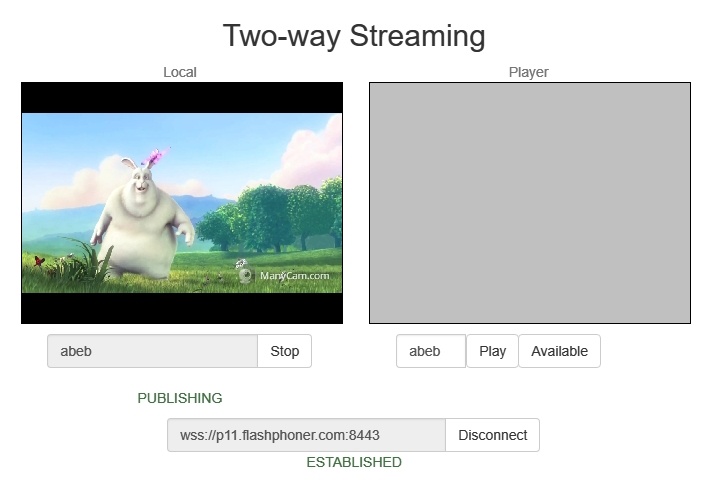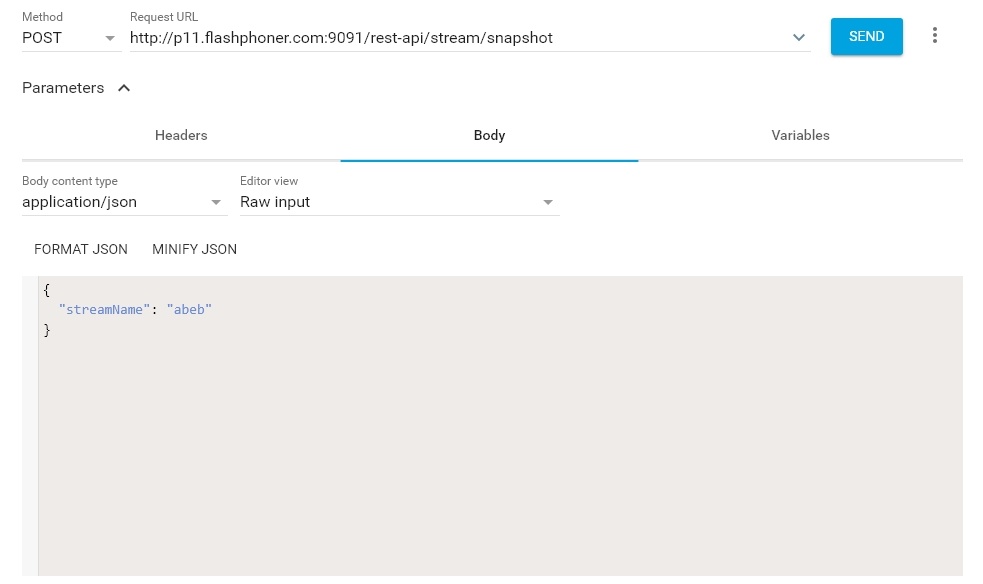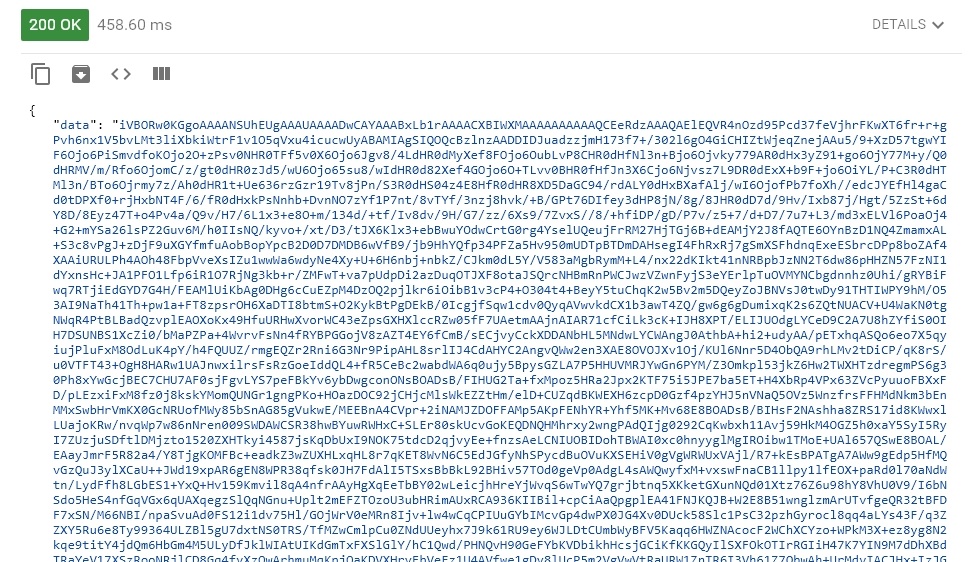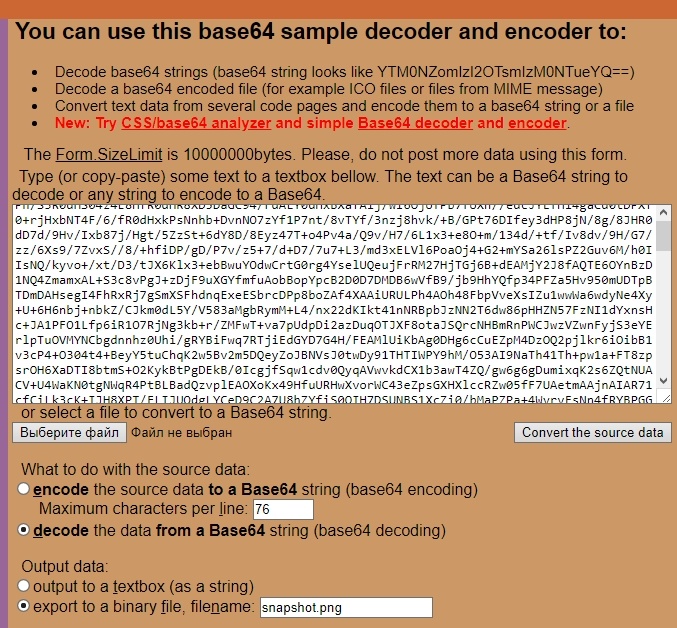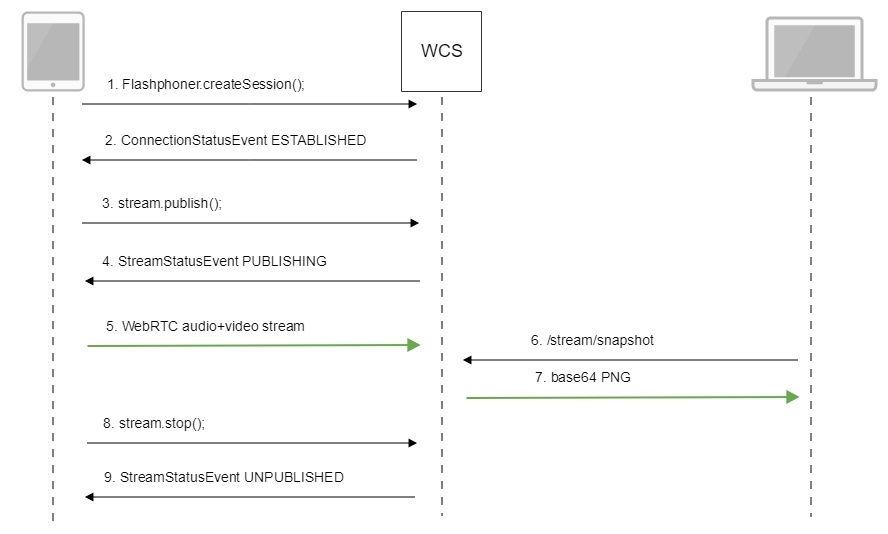| Table of Contents |
|---|
Overview
WCS provides a way to take a snapshot of the published stream using REST-queries as well as using JavaScript API.
Supported protocols
- WebRTC
- RTMP
- RTSP
Supported snapshot formats
- PNG
Operation flowchart
1: Using the REST query
...
| Include Page | ||
|---|---|---|
|
...
2: Using JavaScript API
- The browser connects to the server via the Websocket protocol and sends the publish command.
- The browser captures the microphone and the camera and sends the WebRTC stream to the server.
- The second browser establishes a connection also via Websocket and sends the play command.
- The second browser receives the WebRTC stream and plays this stream on the page.
- The second browser invokes stream.snapshot() to take a snapshot.
- The second browser receives a response with the base64-encoded snapshot of the stream.
REST queries
WCS-server supports the /stream/snapshot REST method to take a snapshot:
A REST-query must be an HTTP/HTTPS POST request as follows:
- HTTP: http://streaming.flashphoner.com:8081/rest-api/stream/snapshot
- HTTPS: https://streaming.flashphoner.com:8444/rest-api/stream/snapshot
Here:
- streaming.flashphoner.com - is the address WCS server
- 8081 - is the standard REST / HTTP port of the WCS server
- 8444 - is the standard HTTPS port
- rest-api - is the required part of the URL
- /stream/snapshot - is the REST method used
REST-methods and response statuses
...
REST-method
...
Example of the REST query
...
Example of the REST response body
...
Response statuses
...
/stream/snapshot
...
| Code Block | ||||
|---|---|---|---|---|
| ||||
{
"streamName" : "64966f33"
} |
...
| Code Block | ||||
|---|---|---|---|---|
| ||||
{
"data": "iVBORw0KGgoAAAANSUhEUgAAAUAAAADwCAYAAABxLb1rAAAACXBIWXMAAAAAAAAAAQCEeRdzAAAQAElEQVR4nOzd95Pcd37feVjhrFKwXT6fr+r+gPvh6nx1V5bvLMt3liXbkiWtrF1v1O5qVxu4icucwUyABAMIAgSIQOQcBzlnzAADDIDJuadzzjmH173f7+/302l6gO4GiCHIZtWjeqZnejAAu5/9+XzD57tgwYIF6Ojo6PiSmvdfoKOjo2O+zPsv0NHR0TFf5v0X6Ojo6Jgv8/4LdHR0dMyXef8FOjo6OubLvP8CHR0dHfNl3n+Bjo6Ojvky779AR0dHx3yZ91+go6OjY77M+y/Q0dHRMV/m/Rfo6OjomC/z/gt0dHR0zJd5/wU6Ojo65su8/wIdHR0d82Xef4GOjo6O+TLvv0BHR0fHfJn3X6Cjo6Njvsz7L9DR0dExX+b9F+jo6OiYL/P+C3R0dHTMl3n/BTo6Ojrmy7z/Ah0dHR1t+Ue636rzGzr19Tv8jPn/S3R0dHS04z4E8HfR0dHR8XD5DaGC94/rdALY0dHxBXafAlj/wI6OjofPb7foXh//edcJYEfHl4gaCd0tDPXf0+rjHxbNT4F/6/fR0dHxkPsNnhb+DvnNO7zYf1P7nt/8vTYf/3nzj8hvk/+B/GPt76DIfey3dHP8jN/8g/8JHR0dD7d/9Hv/Ixb87j/Hgt/5ZzSt+6dY8D/8Eyz47T+o4Pv4a/Q9v/H7/6L1x3+e8O+m/134d/+tf/Iv8dv/9H/G7/zz/6Xs9/7ZvxS//8/+hfiDP/gD/P7v/z5+7/d+D7/7u7+L3/md3xELVl6PoaOj4"
} |
...
200 - Snapshot is taken
404 - Stream not found
Parameters
...
Parameter name
...
Description
...
Example
...
streamName
...
Unique stream name
...
64966f33
...
data
...
Snapshot file encoded to base64
...
iVBORw0KGgoAAAANSUhEUgAAAUAAAADwCAYAAABxLb1rAAAACXBIWXMAAAAAAAAAAQCEeRdzAAAQA
Sending the REST query to the WCS server
To send the REST query to the WCS server you need to use a REST-client.
JavaScript API
The snapshot method of the Stream object in WebSDK is intended to take stream snapshots. Example of use of this method can be found in the Stream Snapshot web applications that publishes a stream and take a snapshot.
1. Creating a new stream from the published stream
code:
| Code Block | ||||
|---|---|---|---|---|
| ||||
function snapshot(name) {
setSnapshotStatus();
var session = Flashphoner.getSessions()[0];
session.createStream({name: name}).on(STREAM_STATUS.SNAPSHOT_COMPLETE, function(stream){
...
} |
2. Invoking the snapshot() method
code:
| Code Block | ||||
|---|---|---|---|---|
| ||||
function snapshot(name) {
setSnapshotStatus();
var session = Flashphoner.getSessions()[0];
session.createStream({name: name}).on(STREAM_STATUS.SNAPSHOT_COMPLETE, function(stream){
...
}).snapshot();
} |
3. Upon receiving the SNAPSHOT_COMPLETE event, the stream.getInfo() function returns the base64 encoded snapshot
code:
| Code Block | ||||
|---|---|---|---|---|
| ||||
function snapshot(name) {
setSnapshotStatus();
var session = Flashphoner.getSessions()[0];
session.createStream({name: name}).on(STREAM_STATUS.SNAPSHOT_COMPLETE, function(stream){
console.log("Snapshot complete");
setSnapshotStatus(STREAM_STATUS.SNAPSHOT_COMPLETE);
snapshotImg.src = "data:image/png;base64,"+stream.getInfo();
...
} |
4. The stream stops
code:
| Code Block | ||||
|---|---|---|---|---|
| ||||
function snapshot(name) {
setSnapshotStatus();
var session = Flashphoner.getSessions()[0];
session.createStream({name: name}).on(STREAM_STATUS.SNAPSHOT_COMPLETE, function(stream){
...
stream.stop();
}).on(STREAM_STATUS.FAILED, function(stream){
setSnapshotStatus(STREAM_STATUS.FAILED);
console.log("Snapshot failed, info: " + stream.getInfo());
}).snapshot();
} |
Quick manual on testing
1. For the test we use:
- the demo server at demo.flashphoner.com;
- the Chrome browser and the REST-client to send queries to the server;
- the Two Way Streaming web application to publish the stream;
- the https://www.motobit.com/util/base64-decoder-encoder.asp service to decode the snapshot.
2. Open the page of the Two Way Streaming application. Click "Connect", then click "Publish" to publish the stream:
3. Open the REST-client. Send the /stream/snapshot query and pass the name of the published stream in parameters:
...
5. Open the online decoder and copy the response content to the form, then click "Convert the source data":
6. Here is the snapshot we have received:
Call flow
Below is the call flow when using the Stream Snapshot example to publish the stream and take a snapshot
1. Establishing a connection to the server.
Flashphoner.createSession(); code
| Code Block | ||||
|---|---|---|---|---|
| ||||
Flashphoner.createSession({urlServer: url}).on(SESSION_STATUS.ESTABLISHED, function(session){
...
}); |
...
ConnectionStatusEvent ESTABLISHED code
| Code Block | ||||
|---|---|---|---|---|
| ||||
Flashphoner.createSession({urlServer: url}).on(SESSION_STATUS.ESTABLISHED, function(session){
//session connected, start streaming
startStreaming(session);
}).on(SESSION_STATUS.DISCONNECTED, function(){
...
}).on(SESSION_STATUS.FAILED, function(){
...
}); |
...
stream.publish(); code
| Code Block | ||||
|---|---|---|---|---|
| ||||
session.createStream({
name: streamName,
display: localVideo,
cacheLocalResources: true,
receiveVideo: false,
receiveAudio: false
...
}).publish(); |
...
StreamStatusEvent, status PUBLISHING code
| Code Block | ||||
|---|---|---|---|---|
| ||||
session.createStream({
name: streamName,
display: localVideo,
cacheLocalResources: true,
receiveVideo: false,
receiveAudio: false
}).on(STREAM_STATUS.PUBLISHING, function(publishStream){
setStatus(STREAM_STATUS.PUBLISHING);
onPublishing(publishStream);
}).on(STREAM_STATUS.UNPUBLISHED, function(){
...
}).on(STREAM_STATUS.FAILED, function(stream){
...
}).publish(); |
...
6. Taking a snapshot of the broadcast. A new stream is created from the published one specially to take a snapshot.
stream.snapshot(); code
| Code Block | ||||
|---|---|---|---|---|
| ||||
function snapshot(name) {
setSnapshotStatus();
var session = Flashphoner.getSessions()[0];
session.createStream({name: name}).on(STREAM_STATUS.SNAPSHOT_COMPLETE, function(stream){
console.log("Snapshot complete");
setSnapshotStatus(STREAM_STATUS.SNAPSHOT_COMPLETE);
snapshotImg.src = "data:image/png;base64,"+stream.getInfo();
//remove failed callback
stream.on(STREAM_STATUS.FAILED, function(){});
//release stream object
stream.stop();
}).on(STREAM_STATUS.FAILED, function(stream){
setSnapshotStatus(STREAM_STATUS.FAILED);
console.log("Snapshot failed, info: " + stream.getInfo());
}).snapshot();
} |
7. Stopping publishing the stream.
stream.stop(); code
| Code Block | ||||
|---|---|---|---|---|
| ||||
function onPublishing(stream) {
$("#publishBtn").text("Stop").off('click').click(function(){
$(this).prop('disabled', true);
stream.stop();
}).prop('disabled', false);
...
} |
8. Receiving from the server an event confirming unpublishing the stream.
StreamStatusEvent, status UNPUBLISHED code
...
| language | js |
|---|---|
| theme | RDark |
...
|


